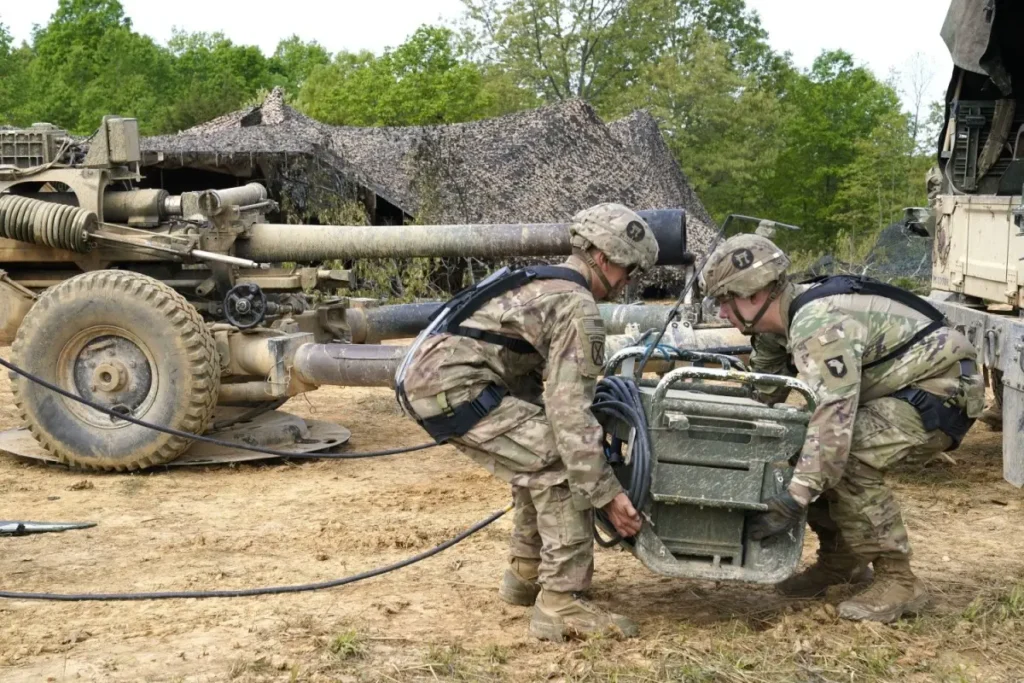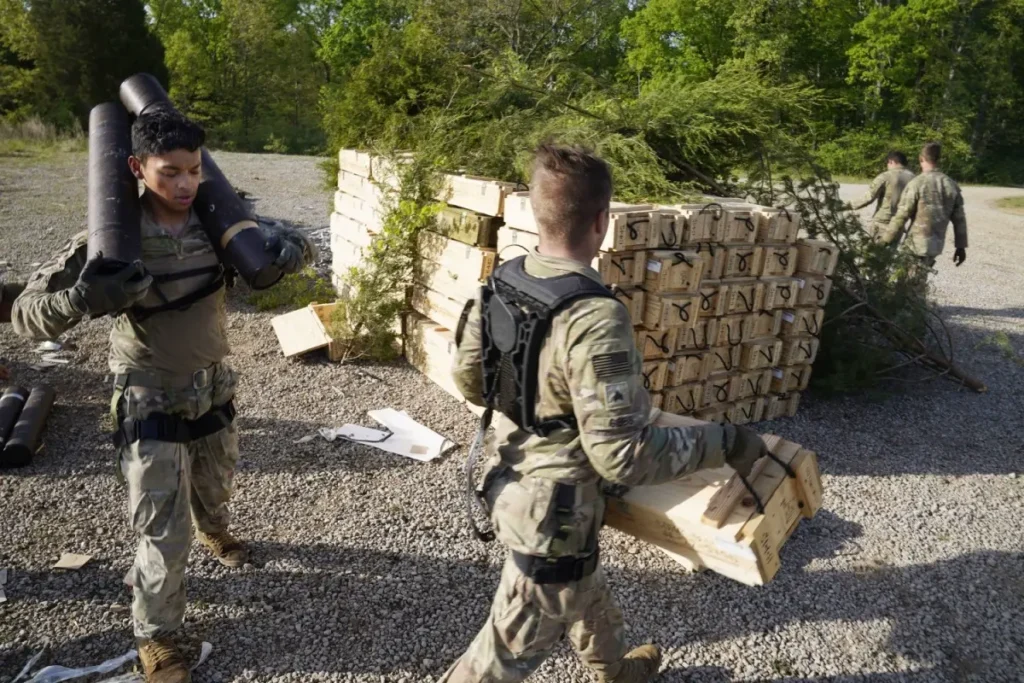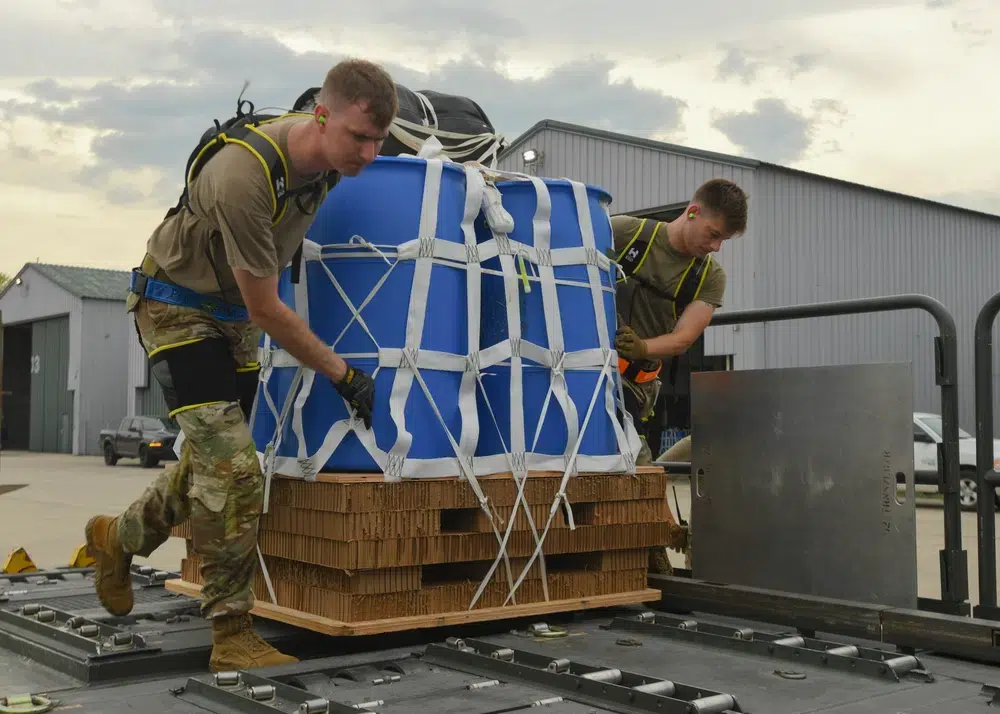This isn’t IronMan, or even Starship Troopers, but it is a nice thing that I wish I had available.
Back-saving exosuits may someday be standard-issue gear for troops.
 The Army’s Pathfinder program, led by a collaborative team of Soldiers from the 101st Airborne Division at Fort Campbell, Kentucky, and engineers at Vanderbilt University, brought about exoskeleton prototypes that augment lifting capabilities and reduce back strain for sustainment and logistics operations. (U.S. Army photo by Larry McCormack)
The Army’s Pathfinder program, led by a collaborative team of Soldiers from the 101st Airborne Division at Fort Campbell, Kentucky, and engineers at Vanderbilt University, brought about exoskeleton prototypes that augment lifting capabilities and reduce back strain for sustainment and logistics operations. (U.S. Army photo by Larry McCormack)
The test was conducted with 101st Airborne Division soldiers at Fort Campbell, Kentucky.As the Army and Air Force move further with the Soldier Assistive Bionic Exosuit for Resupply, or SABER, as the exosuit is called, Karl Zelik, its lead researcher, says the concept and testing success illustrates how exosuits may soon be as commonplace as combat boots and covers.

“Seeing things firsthand, I did not realize just how extreme the physical demands are that they’re under,” Zelik said. “A lot of our work was with civilian workers, people that work very hard, maybe in manufacturing or logistics, and they lift and carry heavy things. But the soldiers just take it to an absolute extreme.”
Zelik said he observed soldiers at work as far back as 2018. The Army invested $1.2 million in the technology in 2021, allowing Zelik and his collaborators to conduct tests with soldiers and develop the device that ultimately would become known as SABER. Most of the observation and testing involved field artillery troops, and Zelik was struck by the potential these troops’ work created for injury through repetitive strain.
“They’d have these boxes of howitzer rounds which weighed 120 pounds, or individual big howitzer shells that were 105, 110 pounds, that they had to lift and carry repeatedly,” Zelik said. “It’s got to be north of 1,000 pounds of strain going through their back.”
The data bears this observation out: Zelik said Army data shows that soldiers sustain 460 back overuse injuries every day.
SABER, Zelik said, increases lifting endurance by 25 to 75%, allowing soldiers to conduct these repetitive lifting tasks for longer periods with less strain, exhaustion, and potential for injury. Yet, there is a catch: while the exosuit does enable troops to increase their maximum lifting potential, it’s not meant to be used this way and may not prevent injury if it is. Rather, Zelik said, it’s designed to guard against injury when troops undertake repeated lifting tasks at set weights – like artillery round-loading.
Ultimately, 100 soldiers with 101st Airborne used the suit over a year through the Army’s Pathfinder program. During a field training exercise within the trial period, according to the study, soldiers who had already been living in the field for two weeks wore a SABER prototype for two to four hours straight, lifting more than 800 105mm howitzer rounds. Following the trials, soldiers ranked the suit’s attributes, including ease of putting on/taking off, range of motion, and comfort, among others. Only two soldiers voiced dissatisfaction, complaining about range of motion and ease of use. Every soldier, however, said they’d be at least somewhat likely to wear the suit if it were made available for everyday work.
The Army Combat Capabilities Development Command (DEVCOM) Research Laboratory is now paying HeroWear, a commercial company Zelik co-founded in 2019, to design and make hundreds more units for Army use. Zelik said the Air Force is also using and evaluating units. The commercial version of the suit, the Apex2, retails for about $1,300.

Cook and Terblanche wore Exosuits during the process to provide feedback to Aerial Port of the Future initiative personnel on their usability. As part of the initiative, Air Mobility Command is collaborating with the Air Force Research Laboratory to modernize the logistics force and develop digitally adept Airmen by updating processes which have remained largely unchanged for more than a decade.
Whether or not these services field a version of SABER, the device represents a paradigm shift in the world of exosuits. The exosuits and exoskeleton prototypes often proposed for military use in past years were more like suits of armor: complex, heavy, and difficult to put on or take off.
US Special Operations Command (SOCOM), which worked for five years to develop the Tactical Assault Light Operator Suit, or TALOS, acknowledged in 2019 that the suit wouldn’t be making its way to the battlefield. A SOCOM spokesman then told Task and Purpose that the prototype was “not currently suitable for operation in a close combat environment,” while other sources at the time said the technology needed refinement, acknowledging its complexity made it vulnerable.
Designing simple suits that integrate easily into regular tasks and aren’t cumbersome to wear or operate may open the door to a new way of thinking about the technology, Zelik said.
“People are beginning to look at it more and more as just a type of wearable tool,” he told Sandboxx News. “And so I think the vantage point that many people are taking is, “Hey, this is a new emerging technology that can improve human performance and improve safety. … And I think that’s where there’s a lot of excitement for the future.”

